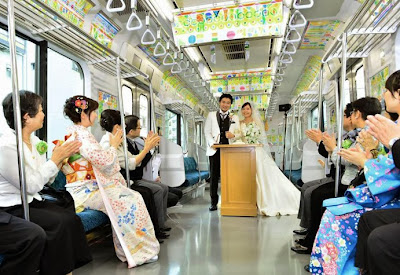In the city of Tokyo forty million passengers use the metropolitan rail system every day. By comparison, the highest daily train usage in Europe is in Germany where the number is only ten million daily. Of Tokyo’s many different train lines, the most notable is the Yamanote Line, a loop line of twenty-nine stations connecting three million passengers a day to the city’s multiple centers. This train line was always a favorite with me not only for its convenience, but also for the appealing lime green of the passenger cars. In my early years in the city the cars were a solid green but in 1985 they became silver and green. The particular green used on the cars, signs and diagrams is a shade of lime green with the poetic name of Bush Warbler green, or uguisu-iro in Japanese.
Stories abound of the jam-packed rush hour trains in Tokyo, and the platform attendants whose job is to push passengers more tightly into the cars before the doors close. Those stories are likely accurate in the telling but fall short of imparting the tactile crush of a Yamanote train ride at 8:00 a.m. on Monday morning. For many years my early mornings in Tokyo included a 7.5 mile crunch on the Yamanote from Shibuya Station to Sugamo, a ride that left me rumpled, poked, twisted, stepped on and rubbed with a mystery mix of hair oil and cologne. You get used to it, and despite the negative aspects, there does not exist a more efficient transportation system anywhere in the world.
Now imagine getting married on such a train. On October 14 that is exactly what one Japanese couple did. The day happened to be the 141st anniversary of the train’s start of operations and as part of the celebration Japan Railway East offered one couple the chance to hold their marriage ceremony on the Yamanote Line on that particular day. Guests were limited to 120, with exclusive use of the 11-car train as it traveled around the twenty-one mile Yamanote Line loop. For the one-hour wedding run, passengers were limited to the couple and their guests, and though the train stopped at all twenty-nine stations, the doors did not open. For one or two in the wedding party there might have been the small problem of no restrooms, meaning holding it in for the duration of the ride and ceremony. The wedding couple and their guests had to agree to having the media present to film the event, surely an advantage since it guaranteed a well-recorded commemoration of the day.
Photos of the newlyweds were hung throughout the train and a video re-enactment of the marriage proposal played repeatedly on screens above the doors during the ceremony. The seated guests applauded the pair as they walked through the cars to No. 6. Other passengers waiting on the platform at Ikebukuro Station greeted the newlyweds with cheers as the train began its circular journey. “We want to cherish the bonds with family and friends that we have confirmed during our wedding preparations,” Suzuki told their guests.
The couple who won the Yamanote wedding lottery are Nobuhiko Suzuki, 27 and Sayaka Tsuchiya, 28, who East Japan Railway found most interesting among the applicants because their courtship took place daily on the No. 6 train during their commute to Shimbashi Station for work.
There was no charge for the train wedding but it was the rail line’s belief that they got publicity enough to justify a few bottles of free champagne. The reception held later at the Hotel Metropolitan Ikebukuro (operated by the train line) was paid for by the wedding couple. Considered by many Japanese to be the most beautiful season, the “Railway Day” wedding fit perfectly with the custom of marrying in autumn.
Oct. 14 is designated Railway Day to commemorate the beginning of the first railway service between Shimbashi and Yokohama stations in 1872. The Yamanote Line went into service in 1903 but the full loop was not completed until 1925. The company launched its lime green cars in 1963, with the stainless steel body coming in 1988. The special train used for the wedding is currently in service to commemorate the 50th anniversary of the lime green cars.




